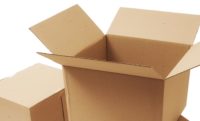Fibre Box Association Column
Corrugated: Future-Friendly, Guilt-Free Packaging

A new global study recently published in the peer-reviewed journal Science Advances found that, of the 8.3 billion metric tons of plastic that has ever been produced, 76% has already become plastic waste. Only 9% has been recycled – a low annual U.S. recovery rate that hasn’t improved since 2012. Much of what isn’t recovered for recycling eventually ends up in the world’s oceans, where it will remain for centuries.
The use of plastics in packaging has been a major driver of overall plastic production. This includes everything from shrink-wrap to the returnable plastic containers (RPCs) used in some shipping industries. Like any container used to transport goods, RPCs have a limited lifespan.
Fortunately, there is a responsible and proven alternative. From start to finish, and at every stop along the way, the familiar corrugated box perpetually excels as the world’s most renewable packaging option. Corrugated is a recycling success story that just keeps getting better, with a stellar 2016 annual U.S. recovery rate of 93%.
Corrugated containers protect even the most delicate contents with a combination of built-in cushioning, thermal protection and stackable rigidity – attributes of an ingenious design built upon the structural properties of curved arches or flutes that make up the inner layer of a corrugated board. Recent innovations in printing and cutting technologies make it possible to elevate corrugated packaging for communicating brand identity and product information to discerning consumers in novel new ways. Corrugated is more relevant today than ever before, and this holds true whether a container is bound for the sales floor or for one family’s doorstep.
When it comes to eco-friendly shipping options, corrugated can’t be beat. Its raw materials are renewably sourced from a combination of recycled paper fiber and trees grown in sustainably managed forests. For old corrugated containers (OCC) that have served their purpose, “the end” is just the beginning! As the most recovered packaging material in use today, cardboard boxes are recycled 7-10 times on average, and the fiber obtained during this process is used to make new boxes and other paper products. When it can no longer be recycled, corrugated biodegrades quickly and safely into natural materials, and is even compostable.
But the positive environmental impacts don’t end there. Corrugated packaging is lightweight and clean, streamlining transportation with fewer trucks, less fuel and lower emissions. Since corrugated is readily recyclable, there are no costs associated with returning empty containers for reuse. Also, the material properties of corrugated naturally inhibit bacterial growth, making it a cleaner choice without requiring additional energy expenditure for sanitizing. In recent years, paper mills have even shifted their primary fuel sources away from oil and coal to cleaner natural gas, which today comprises 75% of the mills’ total fuel mix.
At once both trusted and innovative, responsible and efficient, economical and completely customized – when it comes to packaging options that can meet any challenge while truly delivering on sustainability – corrugated is the natural choice.
The Corrugated Packaging Alliance (CPA) is a corrugated industry initiative, jointly sponsored by the American Forest & Paper Association (AF&PA), The Independent Packaging Association (AICC), Fibre Box Association (FBA) and TAPPI.
Looking for a reprint of this article?
From high-res PDFs to custom plaques, order your copy today!






